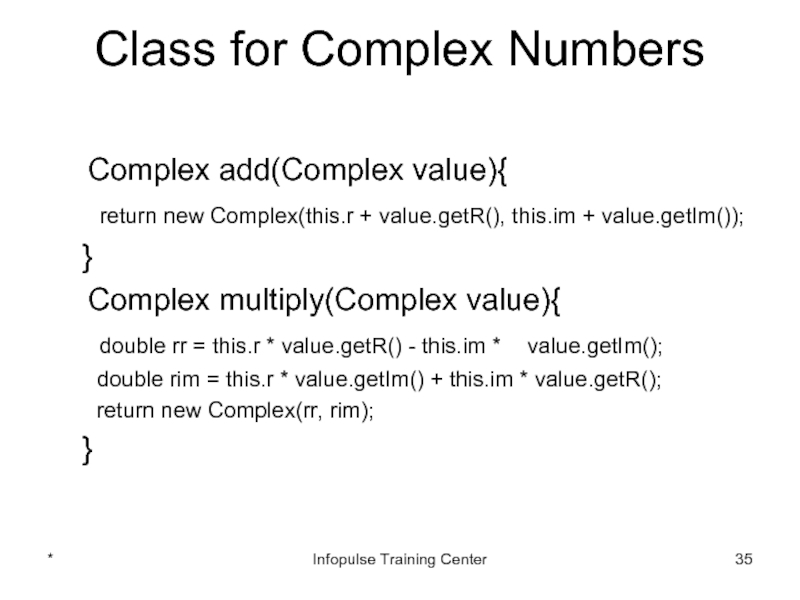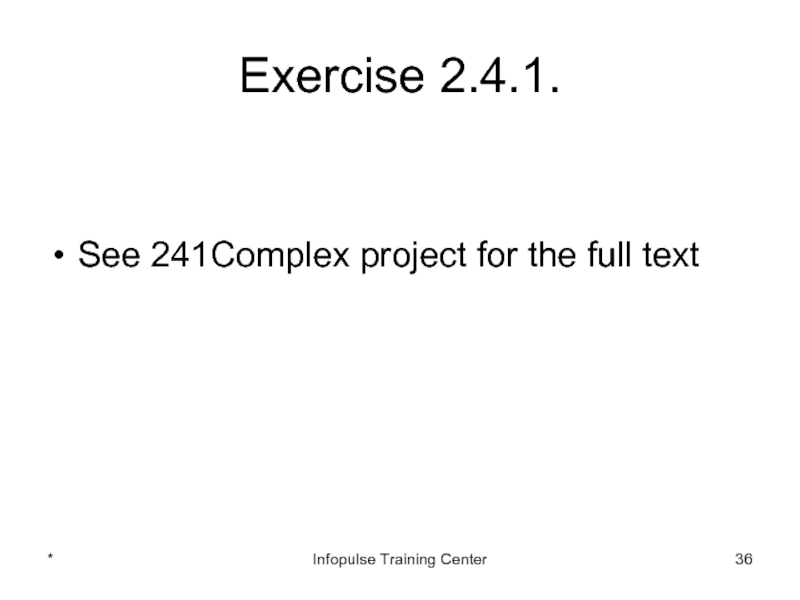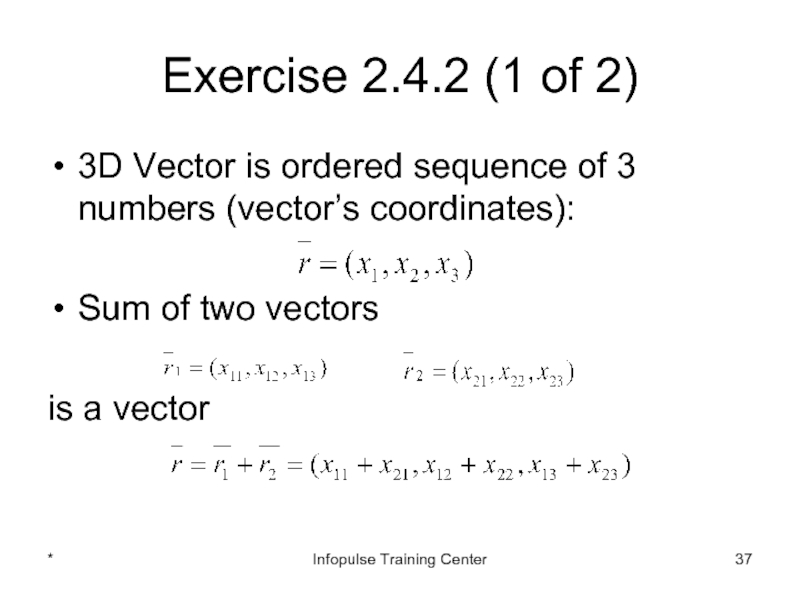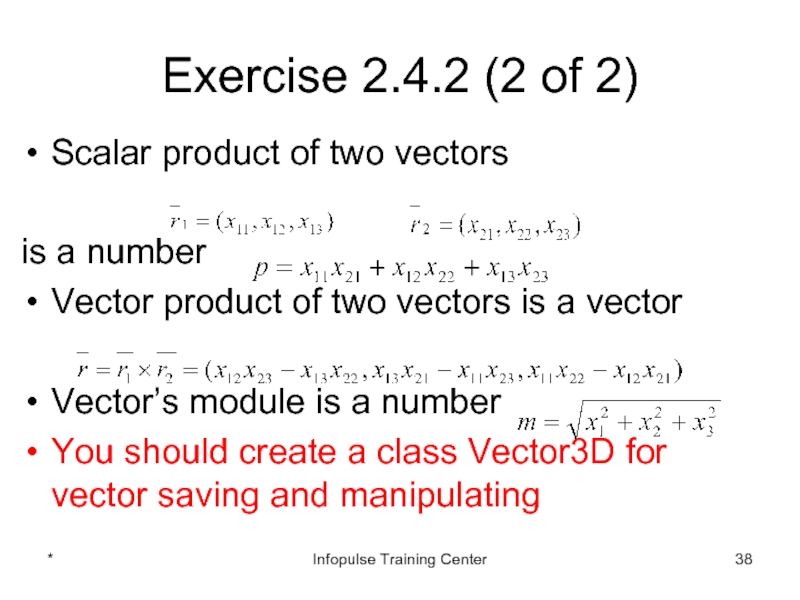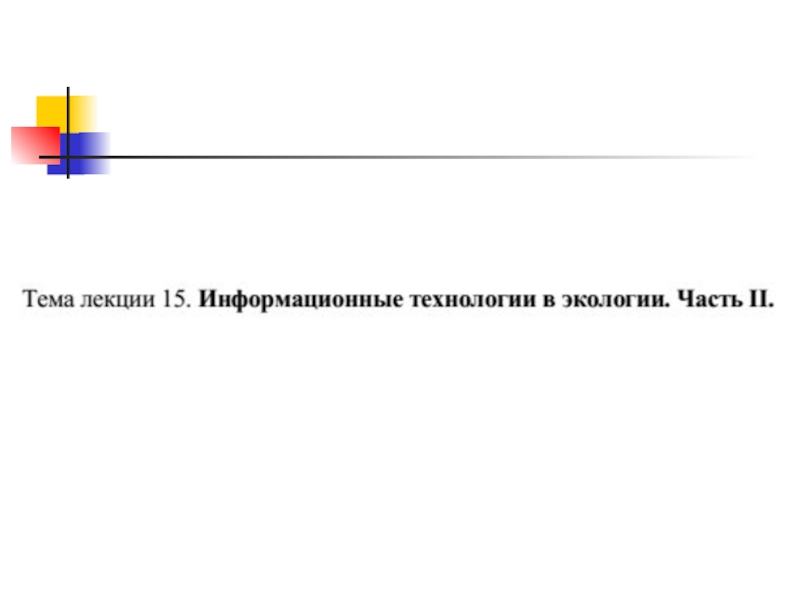- Главная
- Разное
- Дизайн
- Бизнес и предпринимательство
- Аналитика
- Образование
- Развлечения
- Красота и здоровье
- Финансы
- Государство
- Путешествия
- Спорт
- Недвижимость
- Армия
- Графика
- Культурология
- Еда и кулинария
- Лингвистика
- Английский язык
- Астрономия
- Алгебра
- Биология
- География
- Детские презентации
- Информатика
- История
- Литература
- Маркетинг
- Математика
- Медицина
- Менеджмент
- Музыка
- МХК
- Немецкий язык
- ОБЖ
- Обществознание
- Окружающий мир
- Педагогика
- Русский язык
- Технология
- Физика
- Философия
- Химия
- Шаблоны, картинки для презентаций
- Экология
- Экономика
- Юриспруденция
2. Java Basics. 4. Java Classes презентация
Содержание
- 1. 2. Java Basics. 4. Java Classes
- 2. Class – why? Classes split application code
- 3. Class Description class name {
- 4. Class Fields Class fields should be declared
- 5. Defining Methods return_type method_name (parameter_list){
- 6. Return Type The return type describes the
- 7. Parameters Any data type is possible for
- 8. Constructors Constructor name should be the same
- 9. Objects Creating Object: class_name object_variable =
- 10. Using the this Keyword this is a
- 11. Complex Numbers (1 of 4) Is it
- 12. Complex Numbers (2 of 4) Is it
- 13. Complex Numbers (3 of 4) Number of
- 14. Complex Numbers (4 of 4) To add
- 15. Exercise 2.4.1. Create a class for saving and manipulating complex numbers. * Infopulse Training Center
- 16. Step by Step Solution Check problem definition.
- 17. Step by Step Solution Check problem definition.
- 18. Class for Complex Numbers /** *
- 19. Step by Step Solution Check problem definition.
- 20. Class for Complex Numbers class Complex {
- 21. Step by Step Solution Check problem definition.
- 22. Class for Complex Numbers /**
- 23. Class for Complex Numbers /**
- 24. Class for Complex Numbers double
- 25. Accessors in Eclipse Right click in text
- 26. Step by Step Solution Check problem definition.
- 27. Class for Complex Numbers /**
- 28. Step by Step Solution Check problem definition.
- 29. Unit Test for getModule I public class
- 30. Unit Test for getModule II public class
- 31. Step by Step Solution Check problem definition.
- 32. Class for Complex Numbers /**
- 33. Class for Complex Numbers Complex add(Complex value){
- 34. Unit Test for getModule public class E241TestComplex
- 35. Class for Complex Numbers Complex add(Complex value){
- 36. Exercise 2.4.1. See 241Complex project for the full text * Infopulse Training Center
- 37. Exercise 2.4.2 (1 of 2) 3D Vector
- 38. Exercise 2.4.2 (2 of 2) Scalar product
Слайд 2Class – why?
Classes split application code to parts (from sophisticated to
Very often class is a model of an object from the real world
Java says: Everything is an object
Class describes object behaviour
Class is a type
*
Infopulse Training Center
Слайд 3Class Description
class name {
// field declarations
// method
}
*
Infopulse Training Center
Слайд 4Class Fields
Class fields should be declared inside class out of all
Fields can have primitive type, or reference type such as array or object
Fields are visible to all instance methods
Fields are automatically initialized (reference types with null, number types with zero, boolean – with false)
*
Infopulse Training Center
Слайд 5Defining Methods
return_type method_name (parameter_list){
// method body
}
Example:
int b = r % 18;
return a * 2 + b;
}
*
Infopulse Training Center
Слайд 6Return Type
The return type describes the value that comes back from
A method can have void return type
Any method that is not declared void must contain a return statement with a corresponding return value
Return statements for void return type is not necessary
*
Infopulse Training Center
Слайд 7Parameters
Any data type is possible for a parameter of a method
Construct
Varargs can be used only in the final argument position
Parameters are passed into methods by value.
The values of the object's fields can be changed in the method
*
Infopulse Training Center
Слайд 8Constructors
Constructor name should be the same as class name
Constructor has no
The compiler automatically provides a no-argument, default constructor for any class without parameters – don’t use this possibility, declare such constructor explicitly
A class can have several constructors (with different sets of parameters)
*
Infopulse Training Center
Слайд 9Objects
Creating Object:
class_name object_variable = new construtor_call;
Declaring a Variable to Refer
class_name object_variable;
Calling an Object's Methods:
object_variable.methodName(argumentList);
*
Infopulse Training Center
Слайд 10Using the this Keyword
this is a reference to the current object
The
class Point {
int x = 0;
int y = 0;
//constructor
Point(int x, int y) {
this.x = x;
this.y = y;
}
}
*
Infopulse Training Center
Слайд 11Complex Numbers (1 of 4)
Is it always possible to solve square
*
Infopulse Training Center
Слайд 12Complex Numbers (2 of 4)
Is it always possible to solve square
No, if it is impossible.
We can expand real number set to complex number set introducing new number type - complex unit i - in such a way:
i * i = -1
*
Infopulse Training Center
Слайд 13Complex Numbers (3 of 4)
Number of a + b * i
Every square equation can be solved within complex numbers set.
Moreover, every algebraic equation (with arbitrary power) always can be solved within complex numbers set.
*
Infopulse Training Center
Слайд 14Complex Numbers (4 of 4)
To add complex numbers use formula
To multiply
To find absolute value of complex number use formula
*
Infopulse Training Center
Слайд 15Exercise 2.4.1.
Create a class for saving and manipulating complex numbers.
*
Infopulse Training
Слайд 16Step by Step Solution
Check problem definition. If it is clear go
Create class
Describe class fields
Create constructors and accessors
Create method prototypes
Create unit tests
Create method bodies
*
Infopulse Training Center
Слайд 17Step by Step Solution
Check problem definition. If it is clear go
Create class
Describe class fields
Create constructors and getters/setters
Create method prototypes
Create unit tests
Create method bodies
*
Infopulse Training Center
Слайд 18Class for Complex Numbers
/**
* Represents complex numbers
*/
class Complex {
}
*
Infopulse
Слайд 19Step by Step Solution
Check problem definition. If it is clear go
Create class
Describe class fields
Create constructors and getters/setters
Create method prototypes
Create unit tests
Create method bodies
*
Infopulse Training Center
Слайд 20Class for Complex Numbers
class Complex {
/**
* Real part of a
*/
double r;
/**
* Imaginary part of a complex number
*/
double im;
}
*
Infopulse Training Center
Слайд 21Step by Step Solution
Check problem definition. If it is clear go
Create class
Describe class fields
Create constructors and getters/setters
Create method prototypes
Create unit tests
Create method bodies
*
Infopulse Training Center
Слайд 22Class for Complex Numbers
/**
* Default constructor sets complex
*/
Complex(){
r = 0.0;
im = 0.0;
}
*
Infopulse Training Center
Слайд 23Class for Complex Numbers
/**
* Initializes a complex
* @param r - real part of a complex number
* @param im - imaginary part of a complex number
*/
Complex(double r, double im){
this.r = r;
this.im = im;
}
*
Infopulse Training Center
Слайд 24Class for Complex Numbers
double getR() { return r; }
double getIm() { return im; }
void setIm(double value){ im = value; }
*
Infopulse Training Center
Слайд 25Accessors in Eclipse
Right click in text editor, and select Source >
Check necessary boxes for creating getters and / or setters, select access modifiers and click Ok button.
*
Infopulse Training Center
Слайд 26Step by Step Solution
Check problem definition. If it is clear go
Create class
Describe class fields
Create constructors and getters/setters
Create method prototypes
Create unit tests
Create method bodies
*
Infopulse Training Center
Слайд 27Class for Complex Numbers
/**
* Returns module of the
*/
double getModule(){
}
*
Infopulse Training Center
Слайд 28Step by Step Solution
Check problem definition. If it is clear go
Create class
Describe class fields
Create constructors and getters/setters
Create method prototypes
Create unit tests
Create method bodies
*
Infopulse Training Center
Слайд 29Unit Test for getModule I
public class E241TestComplex {
public static void main(String[]
Complex test1 = new Complex();
test1.setR(3.0);
test1.setIm(4.0);
System.out.println("module = " + test1.getModule());
}
}
*
Infopulse Training Center
Слайд 30Unit Test for getModule II
public class E241TestComplex {
public static void main(String[]
Complex test1 = new Complex();
test1.setR(3.0);
test1.setIm(4.0);
double res = test1.getModule();
if (res == 5.0){
System.out.println("getModule test is true");}
else{
System.out.println("getModule test failed");}
}
}
*
Infopulse Training Center
Слайд 31Step by Step Solution
Check problem definition. If it is clear go
Create class
Describe class fields
Create constructors and getters/setters
Create method prototypes
Create unit tests
Create method bodies
*
Infopulse Training Center
Слайд 32Class for Complex Numbers
/**
* Returns module of the
*/
double getModule(){
return Math.sqrt(r * r + im * im);
}
*
Infopulse Training Center
Слайд 33Class for Complex Numbers
Complex add(Complex value){
}
Complex multiply(Complex value){
}
*
Infopulse Training
Слайд 34Unit Test for getModule
public class E241TestComplex {
public static void main(String[] args)
Complex conjugate1 = new Complex(3.0, 2.0);
Complex conjugate2 = new Complex(3.0, -2.0);
Complex result = conjugate1.add(conjugate2);
r = result.getR(); im = result.getIm();
if ((r == 13.0) && (im == 0.0)){
System.out.println("multiply test 1 is true");}
else{ System.out.println("multiply test 1 failed");}
}
}
*
Infopulse Training Center
Слайд 35Class for Complex Numbers
Complex add(Complex value){
return new Complex(this.r
}
Complex multiply(Complex value){
double rr = this.r * value.getR() - this.im * value.getIm();
double rim = this.r * value.getIm() + this.im * value.getR();
return new Complex(rr, rim);
}
*
Infopulse Training Center
Слайд 37Exercise 2.4.2 (1 of 2)
3D Vector is ordered sequence of 3
Sum of two vectors
is a vector
*
Infopulse Training Center
Слайд 38Exercise 2.4.2 (2 of 2)
Scalar product of two vectors
is a number
Vector
Vector’s module is a number
You should create a class Vector3D for vector saving and manipulating
*
Infopulse Training Center

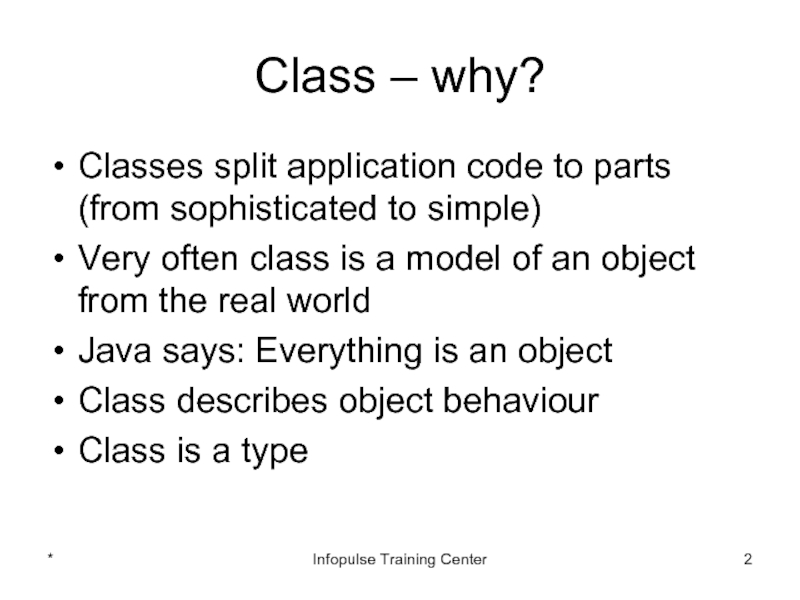
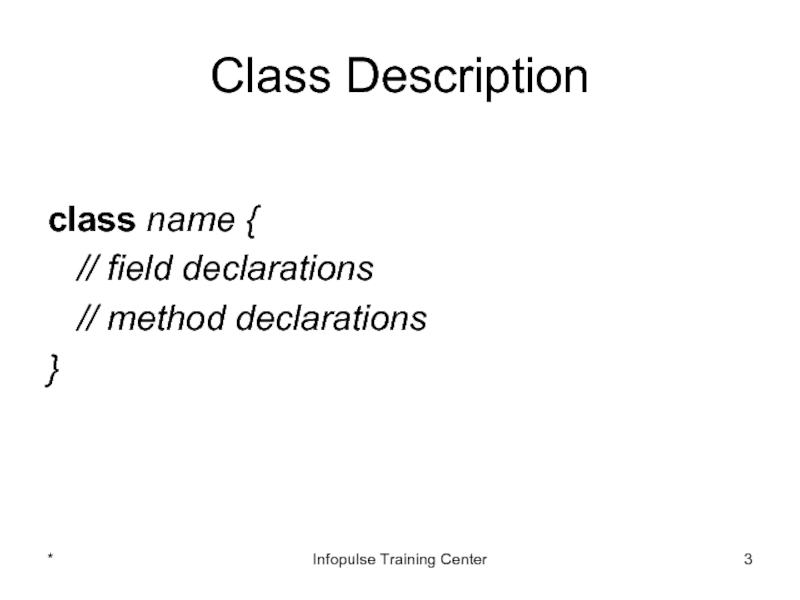
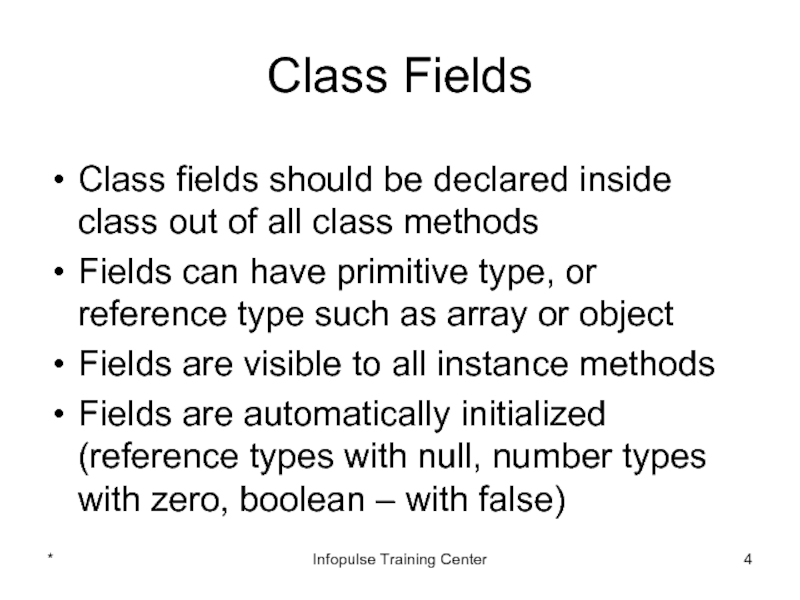
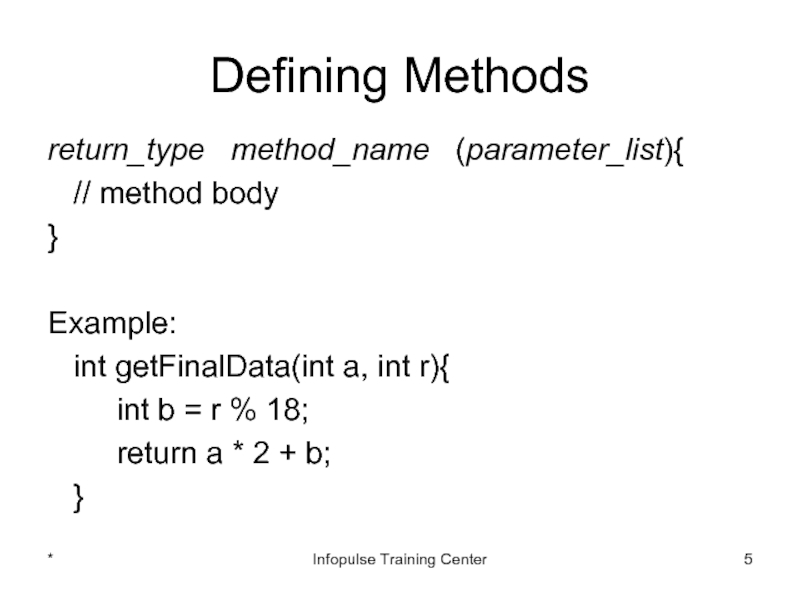
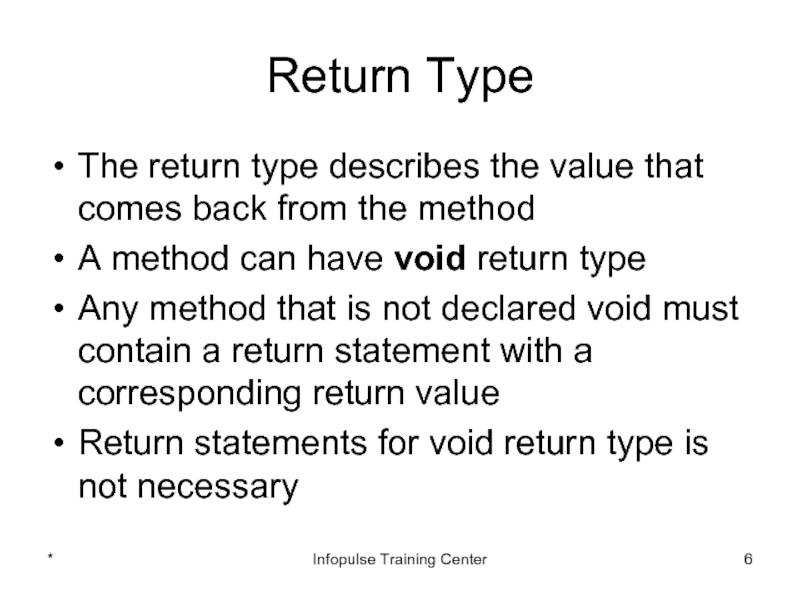
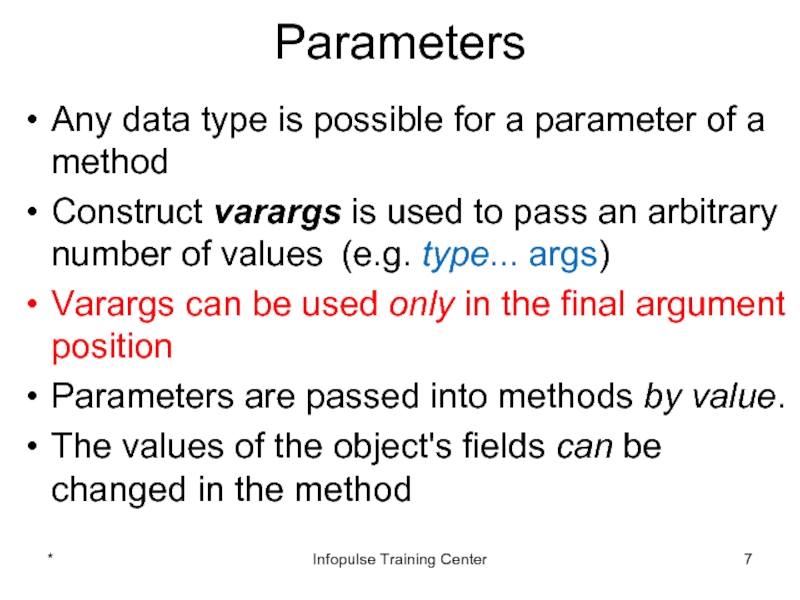
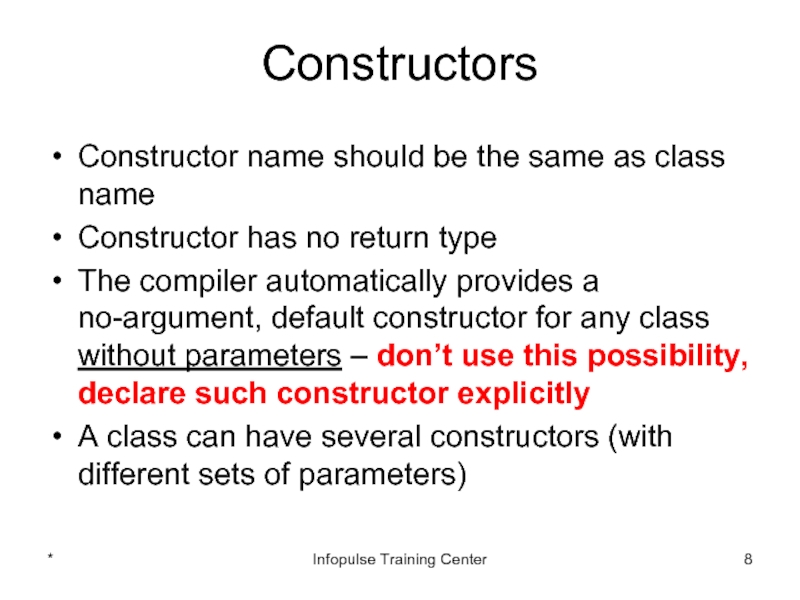
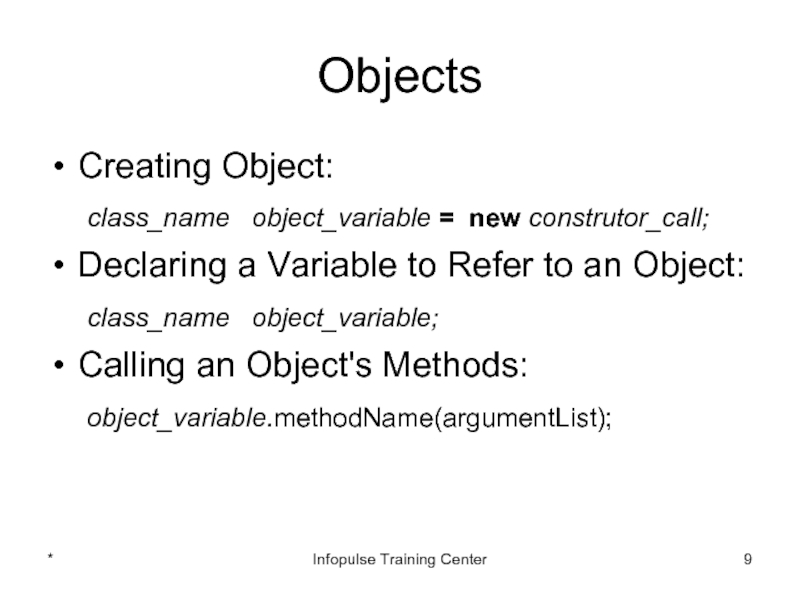
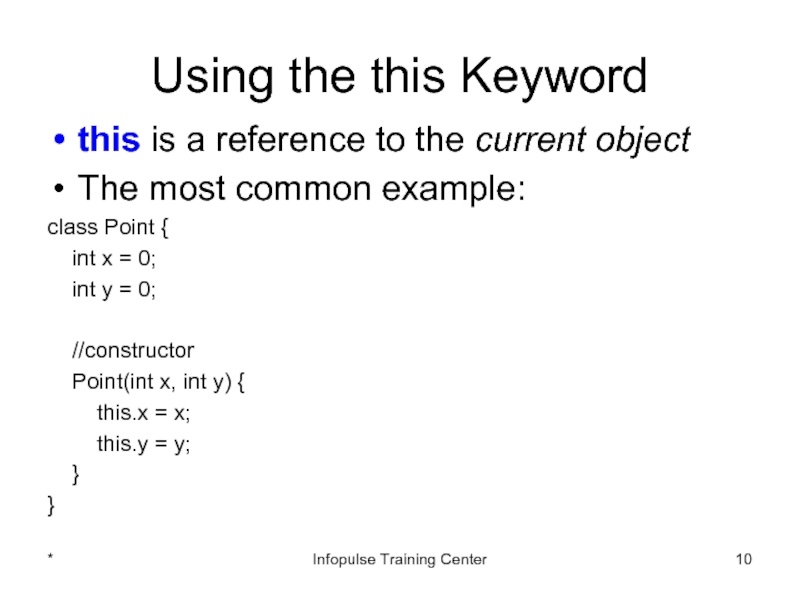
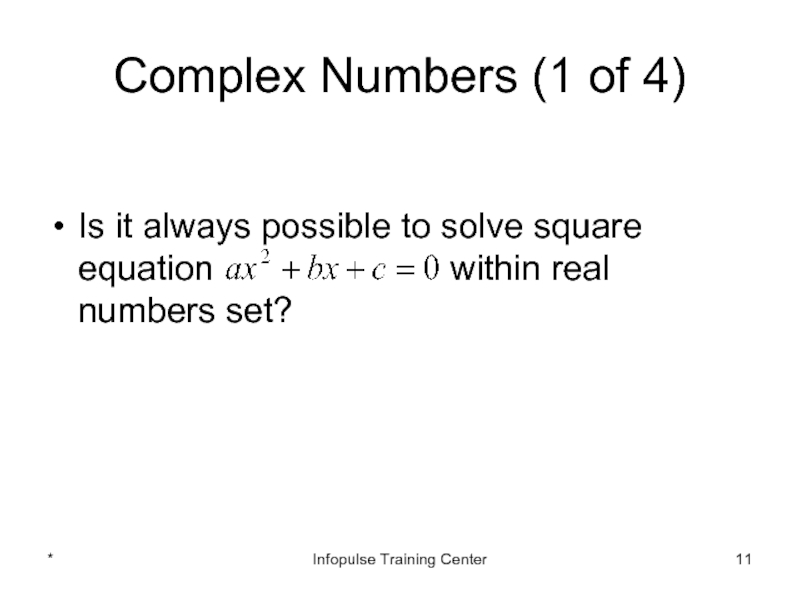
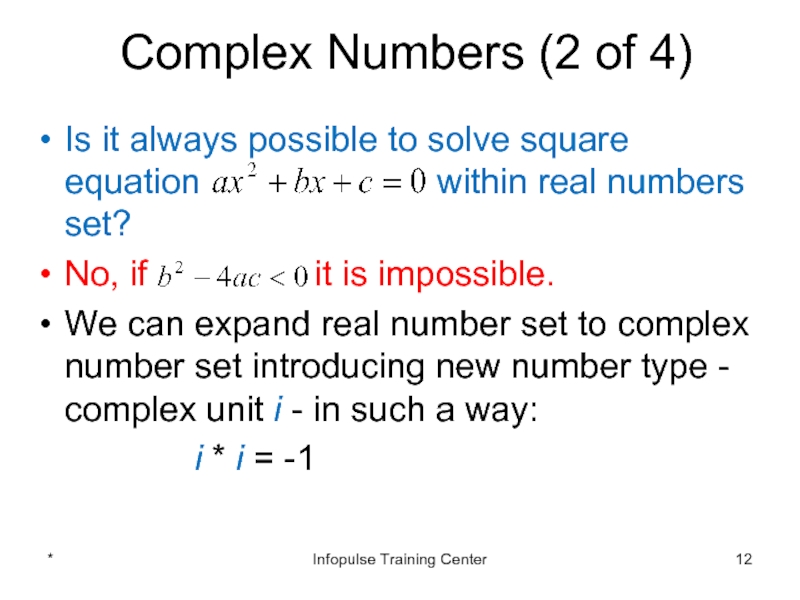
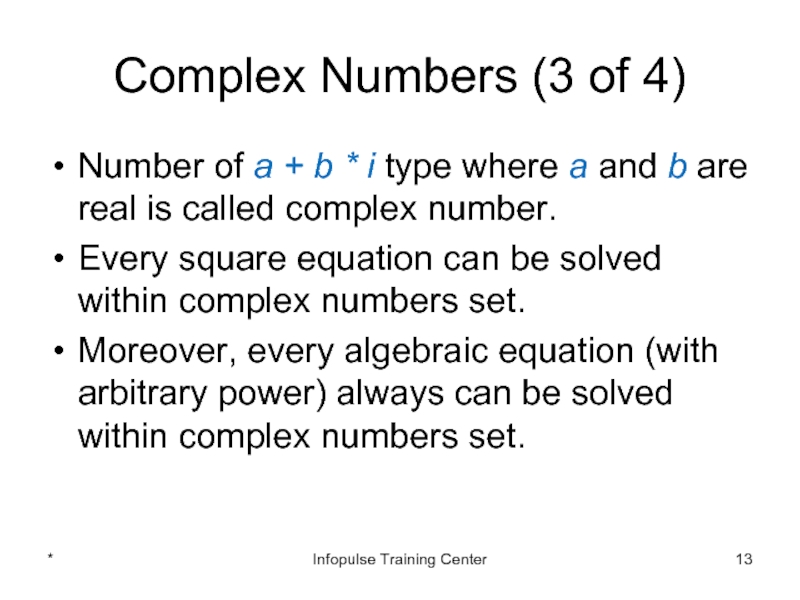

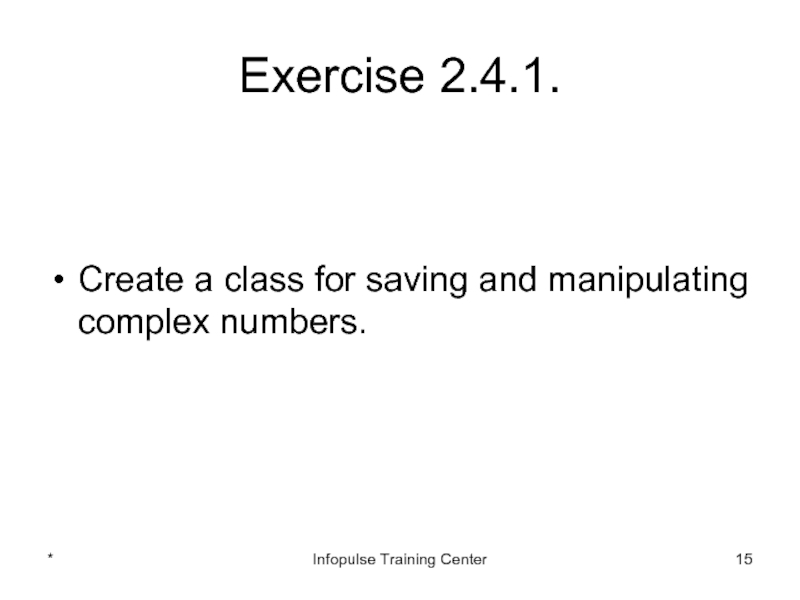

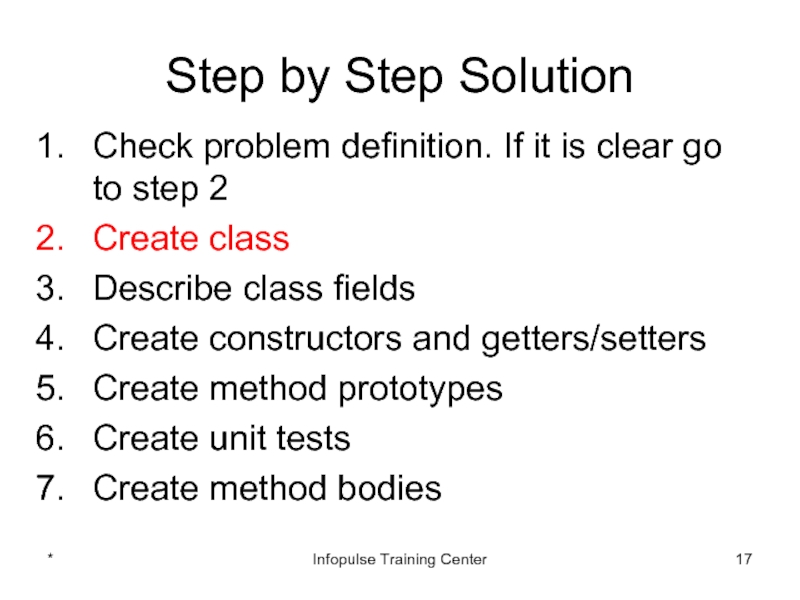
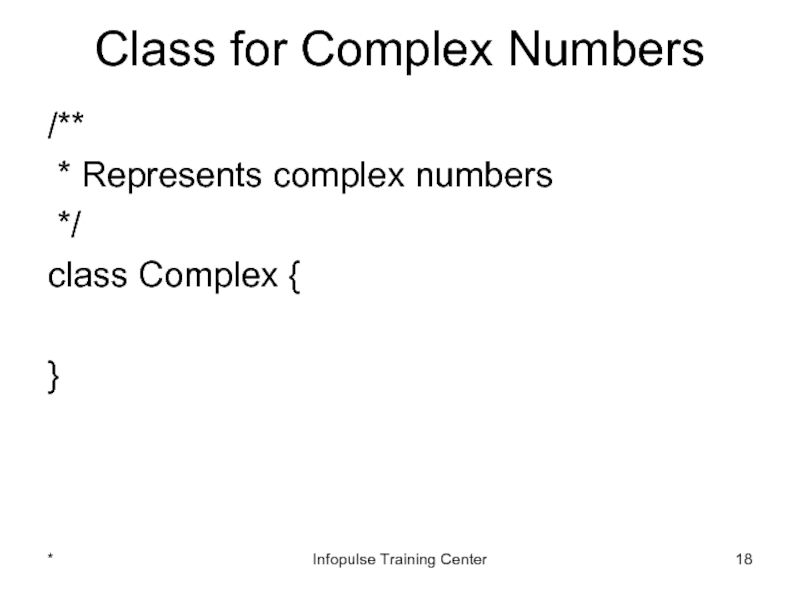
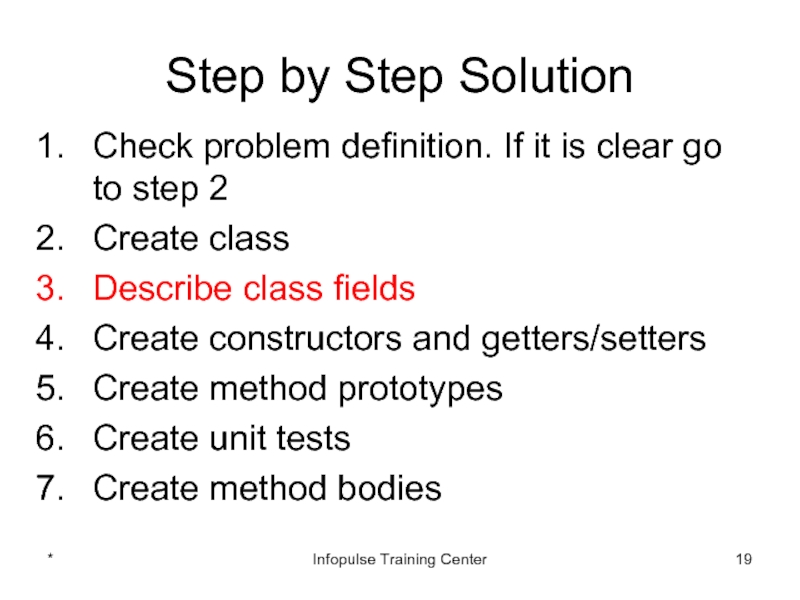
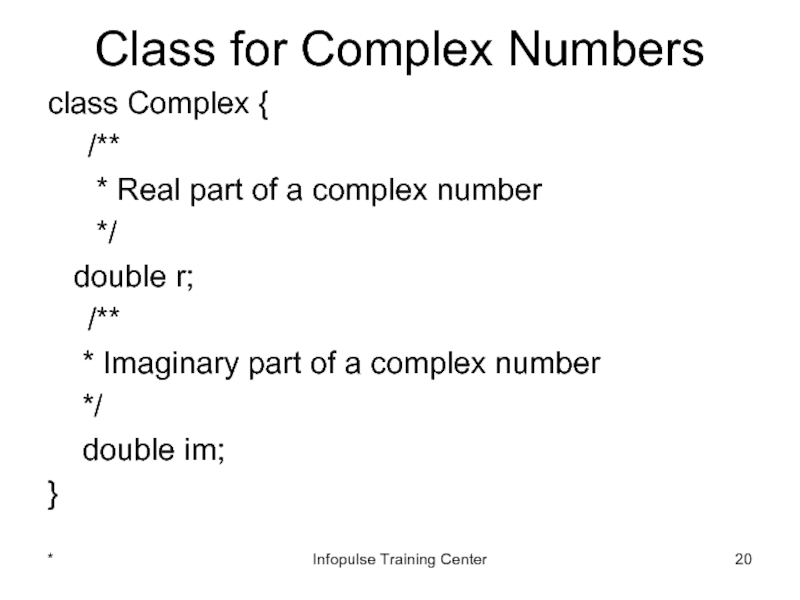
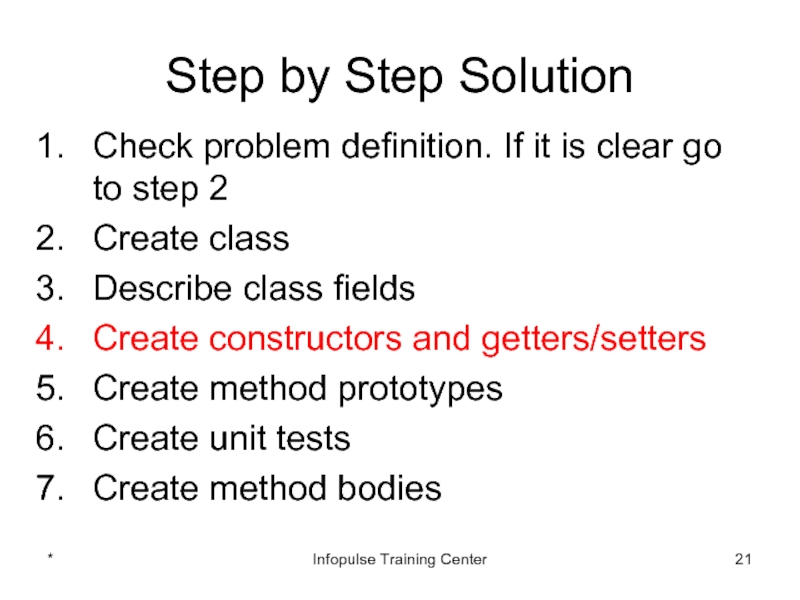
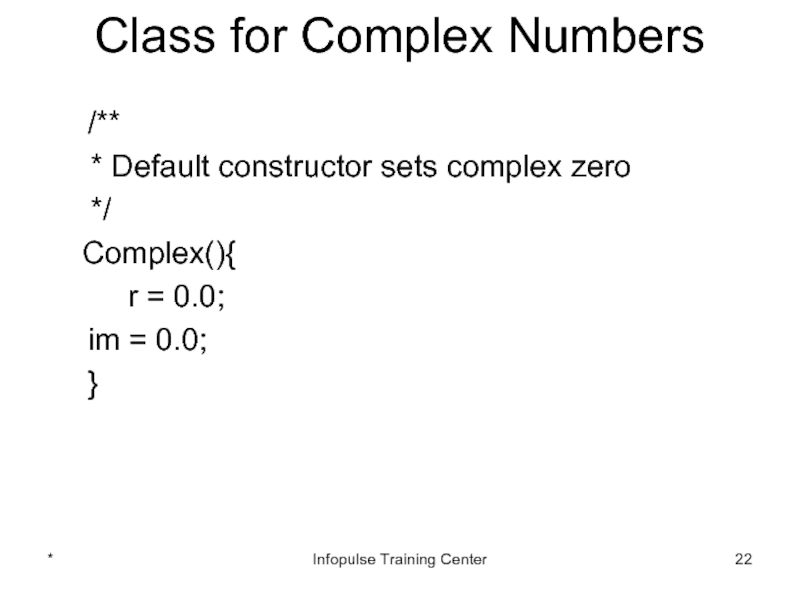
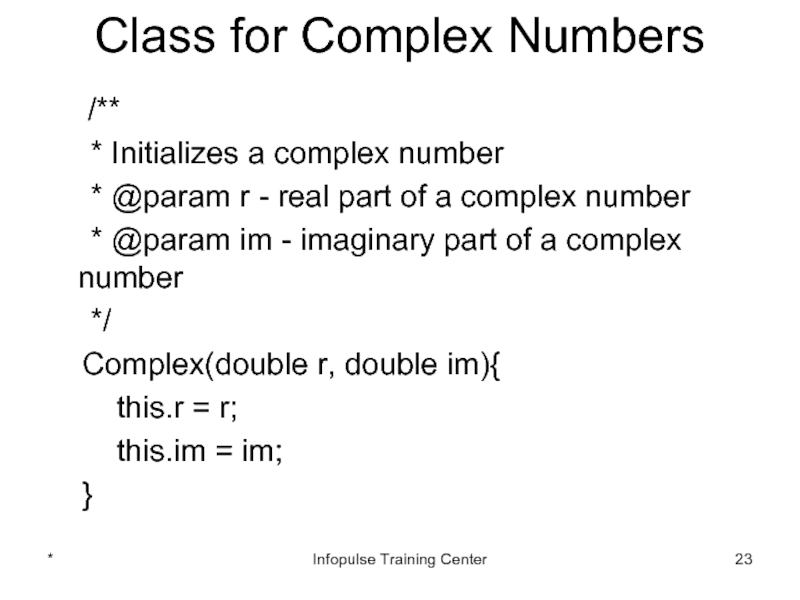
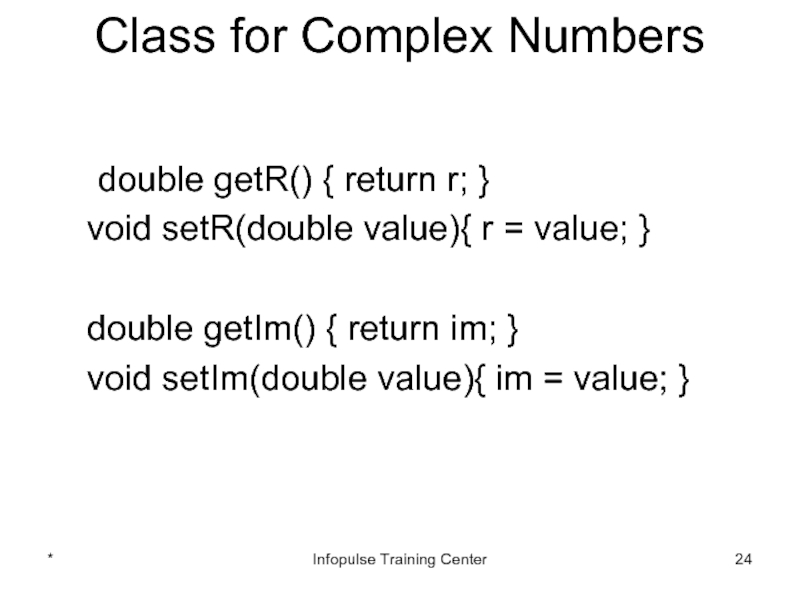
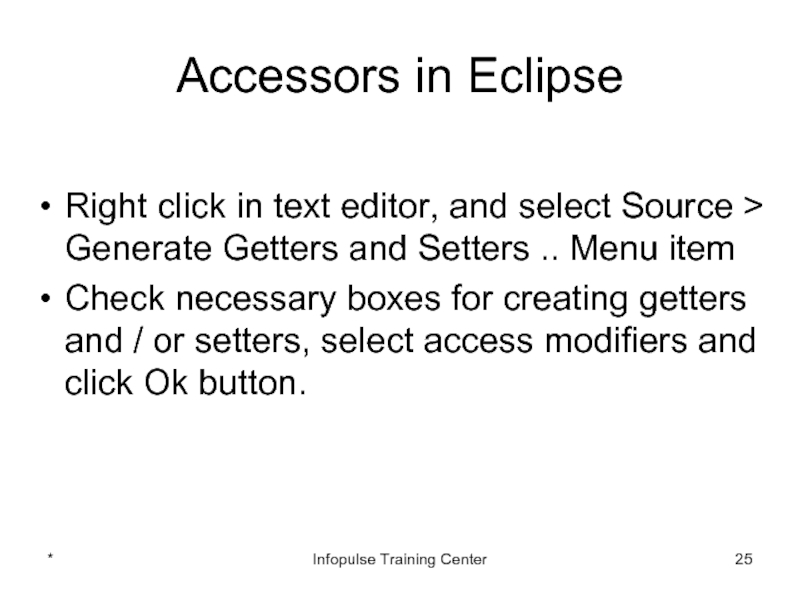
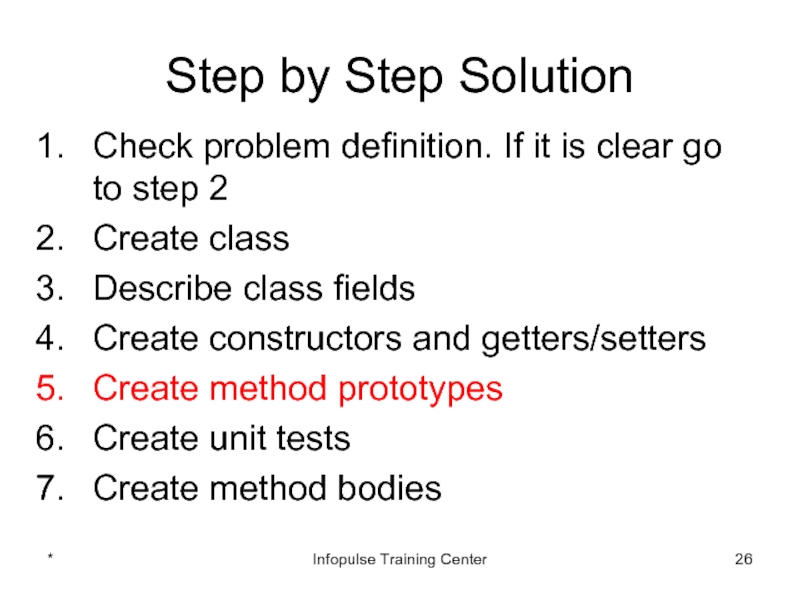
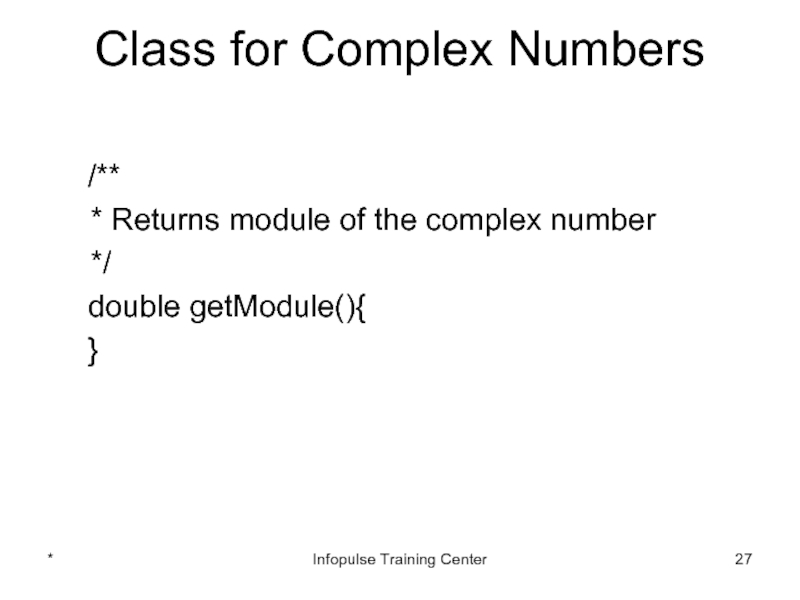
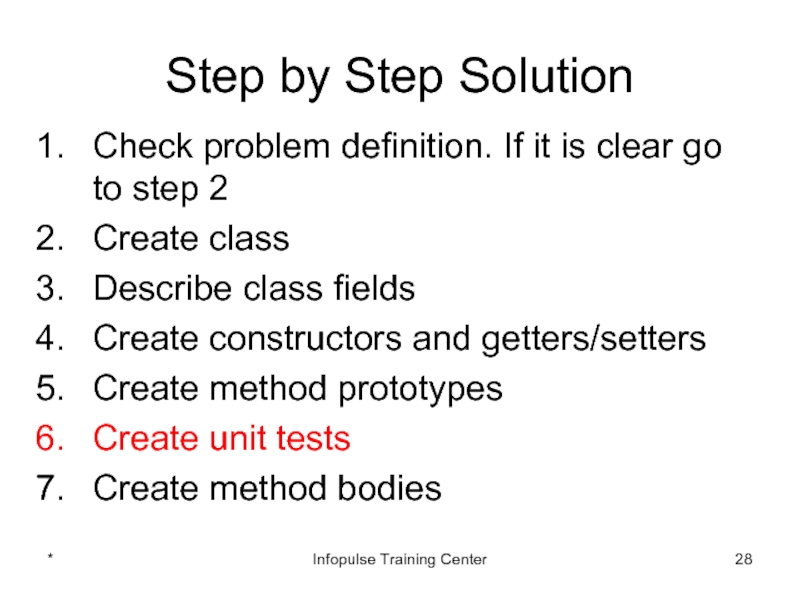
![Unit Test for getModule Ipublic class E241TestComplex { public static void main(String[] args) { Complex test1 =](/img/tmb/2/182405/d055e88d62b3429fe00889dd029cf864-800x.jpg)
![Unit Test for getModule IIpublic class E241TestComplex { public static void main(String[] args) { Complex test1 =](/img/tmb/2/182405/44b18de72b232de74ce5bf22f9dd9552-800x.jpg)
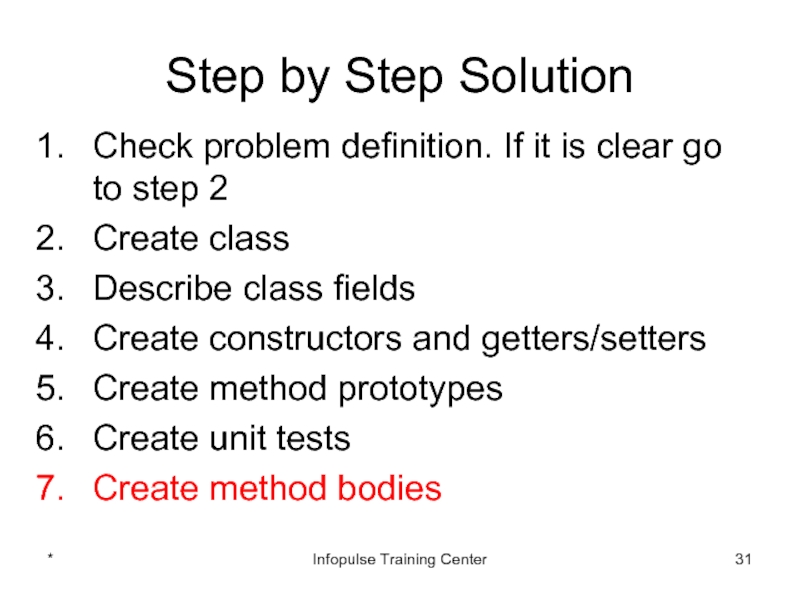
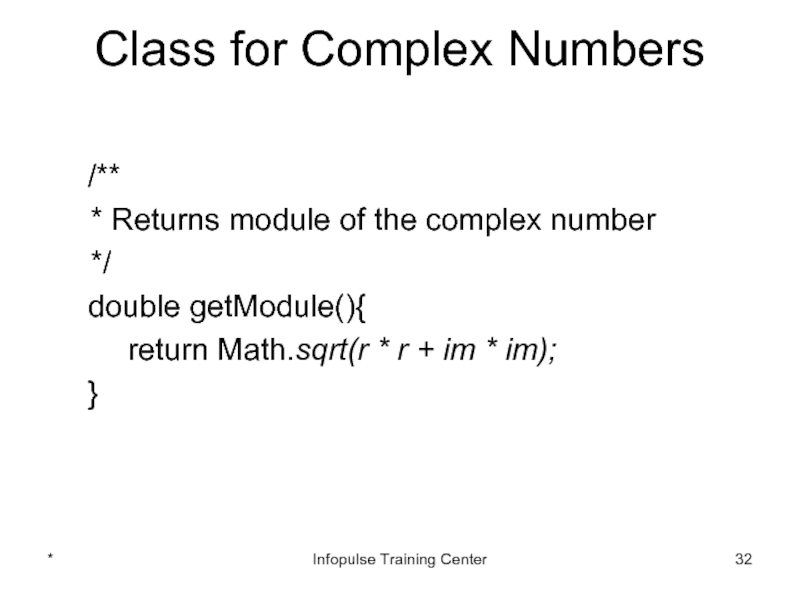
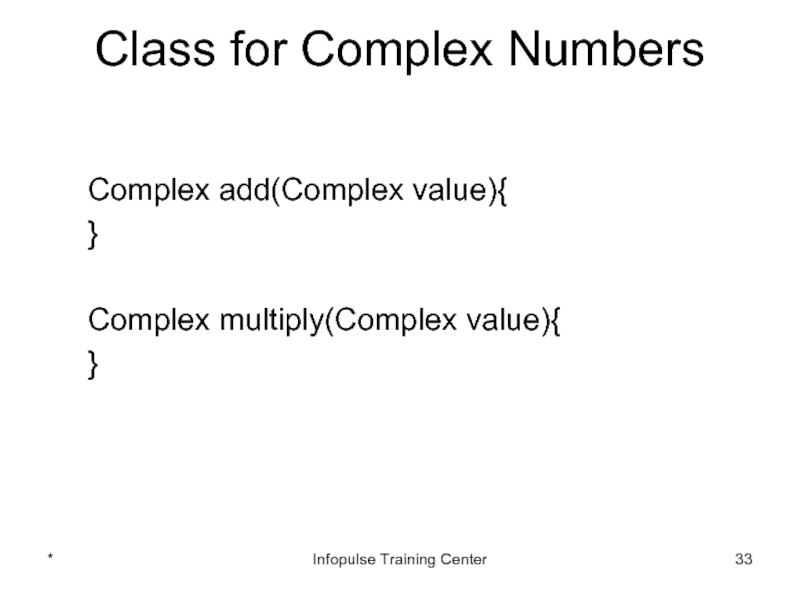
![Unit Test for getModulepublic class E241TestComplex { public static void main(String[] args) { Complex conjugate1 = new](/img/tmb/2/182405/8d1ab5cec87559d8ba031a7456c4361a-800x.jpg)
